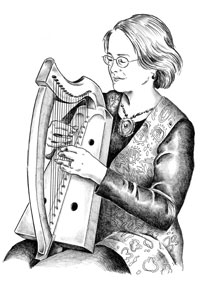The Instrument

The wire strung harp is often called the Irish or Scottish harp. It is an early musical instrument; the oldest extant wire strung harp dates from perhaps as early as the 14th century. It was often used to accompany poetry or song. It may also be called the clàrsach, though this word can also refer to other small harps. Some people think of it as a Celtic harp, and others refer to it as the Gaelic harp, but truly the instrument is not limited to any one country or language.
What makes this harp so special is that it is strung with metal strings, producing the bell–like ring for which it is most famous. It is generally strung with brass or bronze strings. Other metals that may be used include steel, sterling silver, and gold.
Much of the quality of a harp‘s sound depends upon its size and other structural characteristics of the individual harp. Some wire strung harps are made with soundboxes carved from a single piece of wood, hollowed out with no glue joints. This will produce a harp with a different sound than a harp with a soundbox made of flat boards glued together. Some harps have wider or narrower soundboxes. There is also a variety in the number of strings; some harps have a range of four or more octaves while others may have only one or two.
An important characteristic of the wire strung harp is that it is often played with fingernails, producing a very clear and bright attack. Many players maintain this old tradition of playing with their fingernails. Playing with the finger pads became the tradition by the late 18th century, giving a less brilliant sound. One might compare the difference in sound between fingernail and finger pad to the difference between a wooden mallet and a wool–covered one on a marimba.
The wire strings must be at a very high tension to produce a good sound. For this reason, the wire strung harp is under more stress than its gut or nylon counterpart. A function of this fact is that the length of wire necessary to produce a certain tone is less than the length of gut required to produce the same musical note. As a consequence, wire strung harps tend to be both smaller and more sturdily built than their gut counterparts. So, while a 32 string gut/nylon harp is a floor harp, the corresponding wire strung harp will be significantly smaller, and may require a stool to bring it up to playing position.

The strings of most wire strung harps fall directly from the tuning pin—there is neither a bridge nor bridge pins. Levers are often absent as well. Not only would running a wire string through a lever risk breakage, but the wire strings are very inelastic. What this means in practical terms is that the point at which the string is “in tune” is very small as compared to the more elastic nylon or gut strings. The levers would have to be incredibly precise.
A few wire harps have blades on them in place of levers. These look like small paddles driven into the wood of the arm next to each string. When the blade is turned to make contact with the string, the string is shortened to produce a higher tone. There is still the problem of precision, but the strings are less liable to break. No wire strung harps had sharping devices until the late 18th or early 19th century.
The historical wire strung harps are diatonic instruments. Many harpers use the modern harmonies and cadences of the major and minor scale within the compass of the individual harp’s tuning. Through the use of traditional modes or scales, some harpers are able to bring interest and varied tonalities to the music. By the time the wire harper adds up the useful pentatonic, hexatonic and modal scales, he or she has at least a dozen “keys” to choose from.